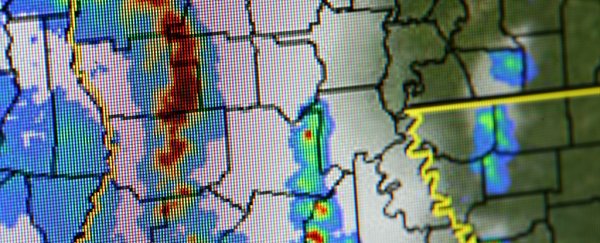When it comes to the weather report, it's not just tomorrow's weather that meteorologists try to discern.
As well as long-term forecasts, weather models are often tasked with predicting meteorological conditions over the next hour or so, known as 'nowcasting'. Over at Google-backed artificial intelligence company DeepMind, researchers have now made a major step forward in the accuracy of precipitation nowcasting.
It's only when you stop and think about it that you realize how important very short-term weather forecasts are – sure, you may just bring your umbrella anyway, but when planning large events, maintaining transport services, dealing with natural disasters, keeping farming running, and much more, minute predictions become crucial.
Specifically, the new model ranks first for accuracy and usefulness in 89 percent of cases when compared against two competitive methods. It uses a type of machine learning called generative modeling, which is able to produce new data points after being trained on existing ones.
The primary job of the new model, called DGMR (Deep Generative Model of Rainfall), is to predict the chance of precipitation across the next one to two hours – and it has been given the nod of approval from more than 50 meteorologists at the Met Office in the UK.
 The system produces short 'radar movies'. (DeepMind)
The system produces short 'radar movies'. (DeepMind)
"This collaboration between environmental science and AI focuses on value for decision-makers, opening up new avenues for the nowcasting of rain, and points to the opportunities for AI in supporting our response to the challenges of decision-making in an environment under constant change," writes the DeepMind Nowcasting Team in a blog post.
The researchers behind DGMR describe making short "radar movies" that generate future radar patterns from past radar patterns – the kind of extrapolation that machine learning is good at (for more generative models, see the creation of fake faces).
Many current nowcasting tools, including pySTEPS, make use of numerical weather prediction (NWP) approaches – they essentially put mathematical models to work on current conditions to work out what future conditions will be like. These are powerful models, but they're more accurate over the longer term.
"These models are really amazing from six hours up to about two weeks in terms of weather prediction, but there is an area – especially around zero to two hours – in which the models perform particularly poorly," Suman Ravuri, staff research scientist at DeepMind, told The Guardian.
DGMR aims to leverage the vast number-crunching power of artificial intelligence while removing some of the blurriness or vagueness in existing machine learning-driven forecasting models, including U-Net – these models can struggle to maintain accuracy in every part of the process.
Now that the new and improved DeepMind model has had the thumbs up from actual meteorologists in the UK, the researchers can look at integrating it with existing weather prediction systems.
There's still a lot of work to do though before you'll be able to know with absolute certainty whether you're going to be able to stay dry for the next couple of hours. The DeepMind team is now attempting to further improve the accuracy of DGMR.
"No method is without limitations, and more work is needed to improve the accuracy of long-term predictions and accuracy on rare and intense events," writes the team.
"Future work will require us to develop additional ways of assessing performance, and further specializing these methods for specific real-world applications."
The research has been published in Nature.
